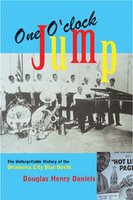
One O’clock Jump: the Unforgettable History of the Oklahoma City Blue Devils
By Douglas Henry Daniels
Beacon Press
0-8070-7136-6
Jazz is closely identified with several American cities, particularly New Orleans, Kansas City, Chicago, and New York. One overlooked jazz municipality is Oklahoma City, the original home of the Blue Devils, a transitional early swing band, rivaling Bennie Moten’s Kansas City band.
Daniels’ One O’clock Jump tells the story of the Blue Devils, a band often assumed to be from Kansas City. Though they toured far and wide, Oklahoma City took civic pride in the ensemble when they returned home. During a low point in their history, a consortium of local African-American business leaders met with bassist Walter Page, one of whom agreed: “Because of the group’s roots in the capitol city and the services they provided to Blacks over the years ‘one of the men put them up in a large room and fed them all’ until they were self-supporting again.” (p. 31)
Some legendary names paid early dues with the Blue Devils, including Lester Young, Jimmy Rushing, Count Basie, Eddie Durham, and a young Ralph Ellison, sitting-in to a limited extent. Indeed, there was something of a revolving door between the Blue Devils and the Moten Band, with many ultimately joining Basie’s band and making history with the Count.
Daniels profiles many of the better known Devils, shedding light on aspects of their lives and careers that might not be well known. Eddie Durham, is generally acclaimed for his early innovations with electrically amplified guitars, but he was also instrumental in the success of Glenn Miller, as the arranger of his signature tune “In the Mood.” Jimmy Rushing is well known as a jazz and blues vocalist, but his religious faith is not as widely reported. According to Daniels, his step-son William Staton “recalled his stepfather reading the Bible all the time, and he blessed the food at mealtime. Rushing ‘was very sincere, and very honest . . . and we went to church once in a while as a group.’” (p. 213)
Obviously, these qualities of Rushing and other Blue Devils explain how this band of jazz musicians was able to forge such ties with their hometown of Oklahoma City, despite the fact that many originally hailed from other Southwestern cities. Although Daniels initially shows too much interest in census data and the early Oklahoma City forefathers, his history of the Blue Devils is a story well worth reading.